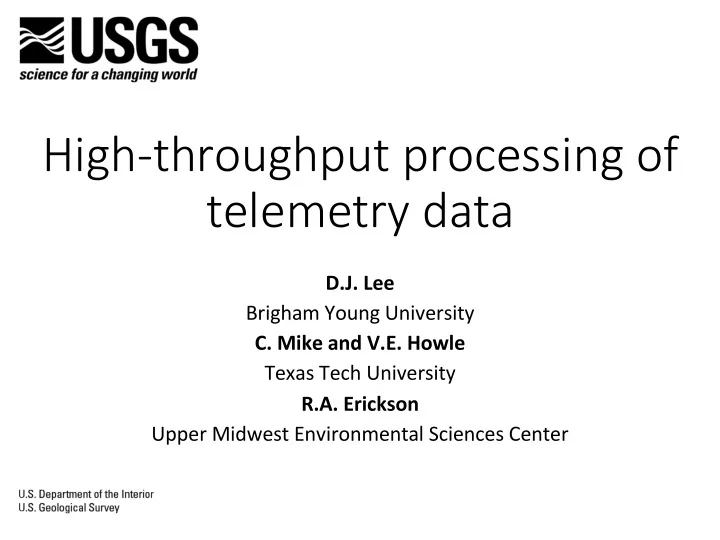

High-throughput processing of telemetry data D.J. Lee Brigham Young University C. Mike and V.E. Howle Texas Tech University R.A. Erickson Upper Midwest Environmental Sciences Center
United States Geological Survey • Core Science Systems • Ecosystems • Energy and Minerals • Environmental Health • Land Resources • Natural Hazards • Water Resources
Upper Midwest Environmental Science Center Providing the scientific information needed by managers, decision makers, and the public to protect, enhance, and restore the ecosystems in the Upper Mississippi River Basin, the Midwest, and worldwide .
Photo by Ryan Hagerty, USFWS
Data challenges • 100GB or more per trial • Requires reasonable turn around times
Old data workflow • Uploaded and processed annually (prior to 2019) • Run locally on any free machines • No cluster management system • Now processed in cloud (2019) • Unsure of cloud vendor • Workflow lacks transparency • 3 rd party collaborator uses closed source software
Data processing steps • Convert return times to coordinates • Process coordinates to cleanup data • Errors caused by collection process • Errors caused by multiple solution to step 1
Software • Docker to containerize code • Python
Converting to coordinates
Converting to coordinates • Match points to receivers • e.g., signal every 2.1 ms might belong to a fish • Solving Pythagorean theorem
Data cleaning The goal is to reconstruct the fish trajectory from the output of the hydroacoustics system. Hydroacoustics Data
Methods • Convolutional filtering • Clustering • Neural networks
Our solution • Denoising auto-encoder (DAE) • The encoder and decoder are implemented with the recurrent neural networks (RNN).
Denoising auto-encoder Computer vision application with DAE [OpenDeep]. DAE structure [Deep Learning A-Z™].
Recurrent neural networks RNN structure [colah’s blog].
Training data preparation • Representation • Generation • Ground truth • Corrupted ground truth
Results
User interface
Recommend
More recommend